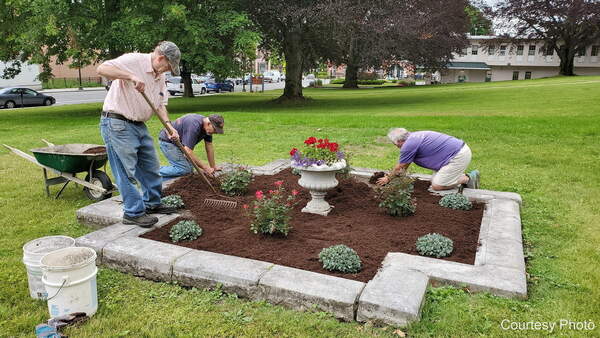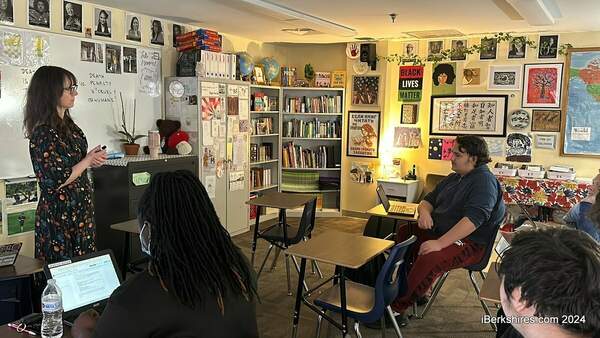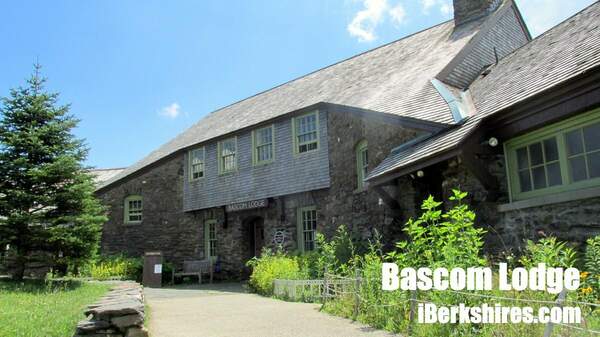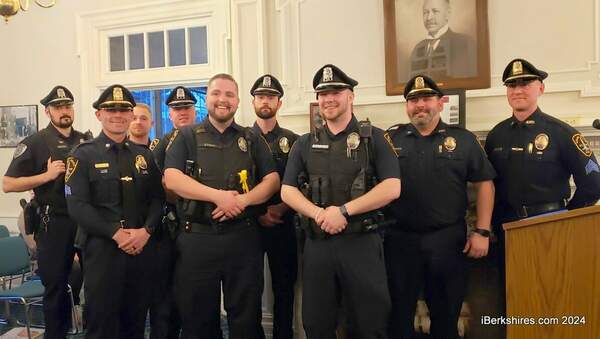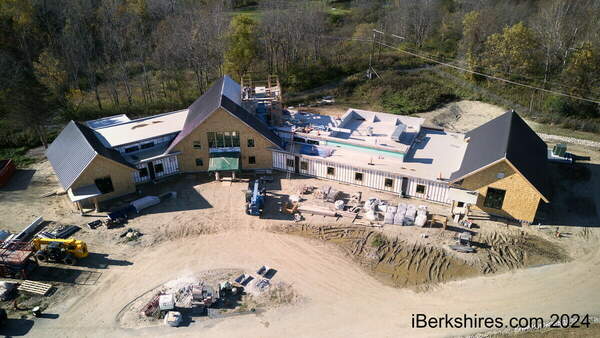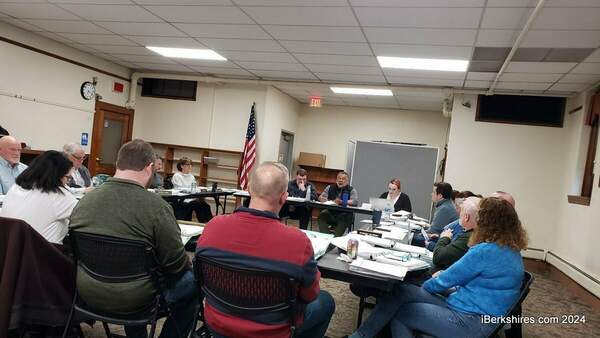Adams Historical Society Brings Plunketts to Life
 The Historical Society offered a history of the Plunkett mansion on Wednesday night by bringing some of the home's well-known residents to life. The Historical Society offered a history of the Plunkett mansion on Wednesday night by bringing some of the home's well-known residents to life. |
ADAMS, Mass. — The Adams Historical Society got into character on Wednesday to present the history of Town Hall and the Plunketts who once resided there.
The Plunketts were one of the richest families that had ever lived in the town and the Plunkett sons Charles T. and William B. were responsible for Plunkett School and the former hospital.
The event was part of this week's Susan B. Anthony Days. Eugene Michalenko welcomed attendees as the caretaker of the Plunkett mansion.
He said the Plunkett family on a larger scale were established throughout Berkshire County.
"You go anywhere in Berkshire County, and I bet there is something with a Plunkett name on it," he said.
Patrick Plunkett was considered the first Irishman in Berkshire County and the Plunketts were originally Catholic, but eventually converted to Protestantism.
President William McKinley was close with the Plunketts because they had similar business policies and wanted to protect local businesses from foreign ones.
Michalenko said W.B. Plunkett was part of the Home Protective Association, which encouraged policy to safeguard local businesses. This policy pushed by McKinley helped power the Plunkett textile empire.
The name of Protection Avenue in North Adams comes from this group, he said, noting that it is near the Cariddi mill, better known as the Greylock Mill when the Plunketts owned it.
McKinley came to Adams three time: once as the governor of Ohio to dedicate a mill and twice as president to see his economic policies in action. On one of these visits, he laid the cornerstone of the Adams Free Library.
Michalenko said there was such a sense of loss in Adams after the president was shot and killed that the town erected a statue. He said there are only two full-size McKinley statues in the world — one in Ohio and one in Adams.
The character of Susan Lapham, who originally lived on the land where Town Hall was built, said there were three homes on the property that had to be moved to construct the Plunkett mansion.
She said one property was easily moved to a block east to Pleasant Street where it resides today, the second had to be moved by constructing a series of dirt terraces until the house was level with B Street.
Lapham lived on B Street, which is now called Bob's Hill because it was owned by a man named Robert Briggs. She said her home also served as the post office and although it is no longer there, it lives on in the children's story series "The Boys of Bob's Hill," written by Charles Pierce Burton whose boyhood home was displaced to build the Plunkett home.
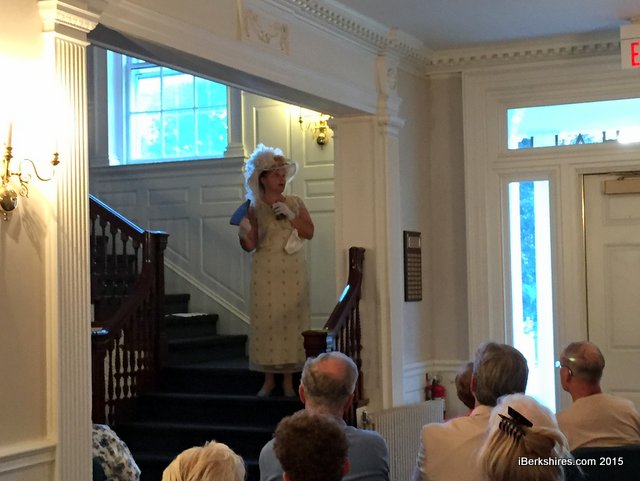 Mrs. Lapham, C.T. Plunkett's mother-in-law, talks about living in the Plunkett mansion. Mrs. Lapham, C.T. Plunkett's mother-in-law, talks about living in the Plunkett mansion. |
"It was read by children all over the United States," Lapham said. "In fact letters would come from California, Florida, and all over from people enjoying the adventures of our spectacular scenery here."
Pierce Burton worked for his brother, who owned the predecessor of the former North Adams Transcript in 1857, and was taken by a group of schoolgirl essays submitted under a pen name. He took interest in the writer and sent a letter to her.
Lantham said the writer was actually her sister Nelly.
"Luckily one day she was sorting the mail and helping father out and she saw that letter addressed to her pen name," she said. "Luckily, she intercepted it before father saw it, but she was intrigued and she decided she was going to check out this Pierce Burton."
She said they eventually got married.
The copper plates used to print the Bob's Hill books were lost though because Burton donated them during World War II because of the need for copper. The books were later reprinted through the North Adams Public Library.
C.T. Plunkett, played by James Loughman, welcomed attendees into his home and said he was born in 1855. He said his father moved to Adams at the age of 30 and eventually purchased a cotton mill that became the Berkshire Cotton Manufacturing Co., now Berkshire Hathaway. He said at one point it was the largest mill in the country; the plants began closing in the mid-20th century.
He had two sisters, who died young, and his brother W.B. who lived next door in his mansion Montrath, which had been built by their father. This is where the president often stayed.
Plunkett said he joined the cotton business at 22 and was involved in other businesses as well. He also held many town offices.
At the age of 24, he married Leila Taylor and they had a son, Charles. Plunkett died in 1927.
"In my will I left large donation to both the town hospital named after my brother, the town library named after me, and the Congregational Church in which we belonged," he said.
Plunkett's mother-in-law, Marie Antoinette Babbitt Taylor, was also on hand and explained some of the less happy memories surrounding the family.
She said C.T. married her in daughter in 1879 and they moved into her home on Maple Street.
Her daughter died during the construction of the Plunkett mansion in the early 1920s and C.T. moved in as a widower with his son and herself.
"My son-in-law Charles and I always had a warm and loving relationship," she said. "But this house was never the center of an active Plunkett social life like it was meant to be ... it never had a proper mistress. If only my daughter Leila had lived here."
Plunkett's son Charles, played also by Michalenko, said he was the last Plunkett to live in the house, although he traveled constantly and did not spend a lot of time there.
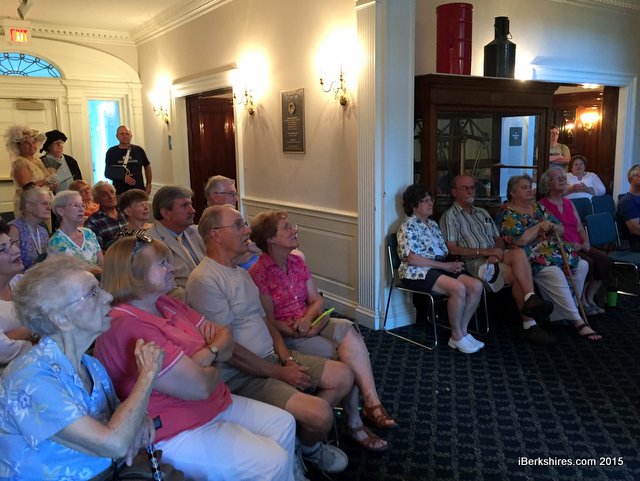 There was a good crowd filling the front lobby of Town Hall for presentation. There was a good crowd filling the front lobby of Town Hall for presentation. |
"I have the distinguished pleasure of being the last Plunkett that lived in this house and probably the last stinking rich Plunkett to ever live in Adams," he said.
He said he did not have to work because of his family's fortune but studied law and eventually practiced it in New York City where he met his wife, Elizabeth.
She died unexpectedly in 1941 on vacation in New Hampshire after retiring to bed after mentioning she was not feeling well.
He said he became a recluse for two months but eventually took off with his niece to Rio de Janeiro, where he died in 1942, suffering from a stroke.
He is buried in a mausoleum with his wife in Maple Street Cemetery.
"You heard about how my father left so much money to the town of Adams, the school, the hospital, the church, and the library, but I didn’t leave one red cent to this town," he said.
Montrath was demolished in 1936; the Plunkett mansion later became the American Legion Post until becoming the "new" Town Hall in the 1990s.
Tags: historical building, historical figure, town hall,

